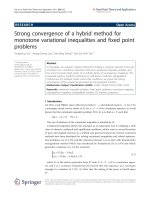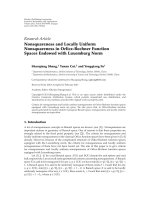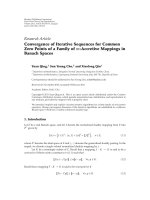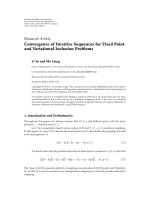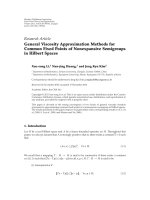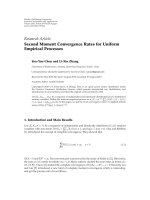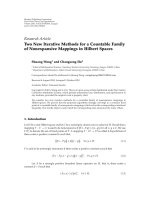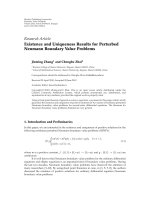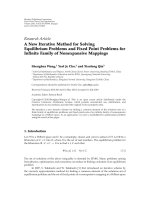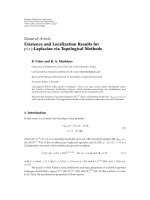Báo cáo hóa học: " Research Article Regularization and Iterative Methods for Monotone Variational Inequalities" ppt
Bạn đang xem bản rút gọn của tài liệu. Xem và tải ngay bản đầy đủ của tài liệu tại đây (495.21 KB, 11 trang )
Hindawi Publishing Corporation
Fixed Point Theory and Applications
Volume 2010, Article ID 765206, 11 pages
doi:10.1155/2010/765206
Research Article
Regularization and Iterative Methods for
Monotone Variational Inequalities
Xiubin Xu
1
and Hong-Kun Xu
2
1
Department of Mathematics, Zhejiang Normal University, Jinhua, Zhejiang 321004, China
2
Department of Applied Mathematics, National Sun Yat-Sen University, Kaohsiung 80424, Taiwan
Correspondence should be addressed to Xiubin Xu,
Received 16 September 2009; Accepted 23 November 2009
Academic Editor: Mohamed A. Khamsi
Copyright q 2010 X. Xu and H K. Xu. This is an open access article distributed under the Creative
Commons Attribution License, which permits unrestricted use, distribution, and reproduction in
any medium, provided the original work is properly cited.
We provide a general regularization method for monotone variational inequalities, where the
regularizer is a Lipschitz continuous and strongly monotone operator. We also introduce an
iterative method as discretization of the regularization method. We prove that both regularization
and iterative methods converge in norm.
1. Introduction
Variational inequalities VIs have widely been studied see the monographs 1–3.A
monotone variational inequality problem VIP is stated as finding a point x
∗
with the
following property:
x
∗
∈ C, Ax
∗
,x− x
∗
≥0, ∀x ∈ C, 1.1
where C is a nonempty closed convex subset of a real Hilbert space H with inner product ·, ·
and norm ·, respectively, and A is a monotone operator in H with domain domA ⊃ C.
Recall that A is monotone if
Ax − Ay,x − y
≥ 0, ∀x, y ∈ dom
A
. 1.2
A typical example of monotone operators is the subdifferential of a proper convex
lower semicontinuous function.
2 Fixed Point Theory and Applications
Variational inequality problems are equivalent to fixed point problems. As a matter of
fact, x
∗
solves VIP 1.1 if and only if x
∗
solves the following fixed point problem FPP,for
any γ>0,
x
∗
P
C
I − γA
x
∗
, 1.3
where P
C
is the metric or nearest point projection from H onto C; namely, for each x ∈ H,
P
C
x is the unique point in C with the property
x − P
C
x
min
x − y
: y ∈ C
. 1.4
The equivalence between VIP 1.1 and FPP 1.3 is an immediate consequence of the
following characterization of P
C
:
Given x ∈ H and z ∈ C; then z P
C
x ⇐⇒
x − z, y − z
≤ 0, ∀y ∈ C. 1.5
The dual VIP of 1.1 is the following VIP:
x
∗
∈ C, Ax, x − x
∗
≥0,x∈ C. 1.6
The following equivalence between the dual VIP 1.6 and the primal VIP 1.1 plays
a useful role in our regularization in Section 2.
Lemma 1.1 cf. 4. Assume that A : C → H is monotone and weakly continuous along segments
(i.e., A1 − tx ty → Ax weakly as t → 0 for x, y ∈ C), then the dual VIP 1.6 is equivalent to
the primal VIP 1.1.
To guarantee the existence and uniqueness of a solution of VIP 1.1, one has to impose
conditions on the operator A. The following existence and uniqueness result is well known.
Theorem 1.2. If A is Lipschitz continuous and strongly monotone, then there exists one and only one
solution to VIP 1.1.
However, if A fails to be Lipschitz continuous or strongly monotone, then the result
of the above theorem is false in general. We will assume that A is Lipschitz continuous, b ut
do not assume strong monotonicity of A. Thus, VIP 1.1 is ill-posed and regularization is
needed; moreover, a solution is often sought through iteration methods.
In the special case where A is of the form A
I − T,withT being a nonexpansive
mapping, regularization and iterative methods for VIP 1.1 have been investigated in
literature; see, for example, 5–19; work related to variational inequalities of monotone
operators can be found in 20–25, and work related to iterative methods for nonexpansive
mappings can be found in 26–33.
The aim of this paper is to provide a regularization and its induced iteration method
for VIP 1.1 in the general case. The paper is structured as follows. In the next section we
present a general regularization method for VI 1.1 with the regularizer being a Lipschitz
continuous and strongly monotone operator. In Section 3, by discretizing the implicit method
Fixed Point Theory and Applications 3
of the regularization obtained in Section 2, we introduce an iteration process and prove its
strong convergence. In the final section, Section 4, we apply the results obtained in Sections 2
and 3 to a convex minimization problem.
2. Regularization
Since VIP 1.1 is usually ill-posed, regularization is necessary, towards which we let B :
H → H be a Lipschitz continuous, everywhere defined, strongly monotone, and single-
valued operator. Consider the following regularized variational inequality problem:
x
ε
∈ C, Ax
ε
εBx
ε
,x− x
ε
≥0,x∈ C. 2.1
Since A εB is strongly monotone, VI 2.1 has a unique solution which is denoted by x
ε
∈ C.
Indeed, VI 2.1 is equivalent to the fixed point equation
x
ε
P
C
I − γ
A εB
x
ε
≡ T
ε
x
ε
, 2.2
where T
ε
P
C
I − γA εB ≡ P
C
I − γF
ε
,withF
ε
A εB.
To analyze more details of VI 2.1or its equivalent fixed point equation 2.2,we
need to impose more assumptions on the operators A and B. Assume that A and B are
Lipschitz continuous with Lipschiz constants L
1
,L
2
, respectively. We also assume that B is
β-strongly monotone; namely, there is a constant β>0 satisfying the property
Bx
1
− Bx
2
,x
1
− x
2
≥β
x
1
− x
2
2
,x
1
,x
2
∈ H. 2.3
Lemma 2.1. If γ is chosen in such a way that
0 <γ<
2εβ
L
1
εL
2
2
,
2.4
then T
ε
is a contraction with contraction coefficient
1 − γ
2εβ − γ
L
1
εL
2
2
< 1.
2.5
Moreover, if
0 <γ<
2εβ
L
1
εL
2
2
ε
2
/4
,
2.6
4 Fixed Point Theory and Applications
then
1 − γ
2εβ − γ
L
1
εL
2
2
≤ 1 −
1
2
βεγ;
2.7
hence, T
ε
is a 1 − 1/2βεγ-contraction.
Proof. Noticing that F
ε
is L
1
εL
2
-Lipschitzian and εβ-strongly monotone, we deduce that,
for x, y ∈ H,
T
ε
x − T
ε
y
2
P
C
I − γF
ε
x − P
C
I − γF
ε
y
2
≤
I − γF
ε
x − I − γF
ε
y
2
x − y − γF
ε
x − F
ε
y
2
x − y
2
− 2γx − y, F
ε
x − F
ε
y γ
2
F
ε
x − F
ε
y
2
≤
1 − γ
2εβ − γ
L
1
εL
2
2
x − y
2
.
2.8
It turns out that if γ satisfies 2.4, then T
ε
is a contraction with coefficient given by the left
side of 2.5.
Finally, it is straightforward that 2.7 holdsprovidedthatγ satisfies 2.6.
Below we always assume that γ satisfies 2.6 so that T
ε
is a 1 − 1/2βεγ-contraction
from C into itself. Therefore, for such a choice of γ, T
ε
has a unique fixed point in C which is
denoted as x
ε
whose asymptotic behavior when ε → 0 is given in the following result.
Theorem 2.2. Assume that
a A : C → H is monotone on C and weakly continuous along segments in C (i.e., A1 −
tx ty → Ax weakly as t → 0 for x, y ∈ C),
b B is β-monotone on H,
c the solution set S of VI 1.1 is nonempty.
For ε ∈ 0, 1,letx
ε
be the unique solution of the regularized VIP 2.1. Then, as ε → 0, x
ε
converges
in norm to a point ξ in S which is the unique solution of t he VIP
ξ ∈ S, Bξ, x − ξ≥0, ∀x ∈ S. 2.9
Therefore, if one takes B to be the identity operator, then the regularized solution x
ε
of the
corresponding regularized VIP 2.1 converges in norm to the minimal norm point of the solution
set S.
To prove Theorem 2.2, we first prove the boundedness of the net x
ε
.
Fixed Point Theory and Applications 5
Lemma 2.3. Assume that A is monotone on C. Assume conditions (b) and (c) in Theorem 2.2.Then
x
ε
is bounded; indeed, for any x
∗
∈ S,
x
∗
− x
ε
≤
1
β
Bx
∗
, ∀ε ∈
0, 1
.
2.10
Proof. We have 2.1 holds for all x ∈ C. In particular, for x
∗
∈ S, we have
Ax
ε
εBx
ε
,x
∗
− x
ε
≥0. 2.11
It turns out that
Ax
ε
,x
∗
− x
ε
εBx
ε
,x
∗
− x
ε
≥0. 2.12
Since A is monotone and B is β-strongly monotone, we have
Ax
∗
,x
∗
− x
ε
≥
Ax
ε
,x
∗
− x
ε
,
Bx
∗
,x
∗
− x
ε
≥
Bx
ε
,x
∗
− x
ε
β
x
∗
− x
ε
2
.
2.13
Substituting them into 2.12 we obtain
εβ
x
∗
− x
ε
2
≤
Ax
∗
,x
∗
− x
ε
ε
Bx
∗
,x
∗
− x
ε
.
2.14
However, since x
∗
∈ S, Ax
∗
,x
∗
− x
ε
≤0. We therefore get from 2.14 that
x
∗
− x
ε
2
≤
1
β
Bx
∗
,x
∗
− x
ε
. 2.15
Now 2.10 follows immediately from 2.15.
Proof of Theorem 2.2. Since x
ε
is bounded by Lemma 2.3, the set of weak limit points as ε →
0 of the net x
ε
, ω
w
x
ε
, is nonempty. Pick a ξ ∈ ω
w
x
ε
and let ε
n
be a null sequence in the
interval 0, 1 such that x
ε
n
→ ξ weakly as n →∞. We first show that ξ ∈ S. To see this we
use the equivalent dual VI of 2.1:
x
ε
∈ C, Ax εBx,x − x
ε
≥0,x∈ C. 2.16
Thus, we have, for all x ∈ C and n,
Ax ε
n
Bx,x − x
ε
n
≥0. 2.17
6 Fixed Point Theory and Applications
Taking the limit as n →∞yields that
Ax, x − ξ≥0, ∀x ∈ C. 2.18
It turns out that ξ ∈ S.
We next prove that the sequence {x
ε
n
} actually converges to ξ strongly. Replacing in
2.15 x
∗
with ξ gives
ξ − x
ε
n
2
≤
1
β
Bξ, ξ − x
ε
n
,x∈ C.
2.19
Now it is straightforward from 2.19 that the weak convergence to ξ of {x
ε
n
} implies strong
convergence to ξ of {x
ε
n
}.
The relation 2.15 particularly implies that, for ε>0,
Bx
∗
,x
∗
− x
ε
,x
∗
∈ S, 2.20
which in turns implies that every point ξ ∈ ω
w
x
ε
⊂ S solves the VIP
ξ ∈ S,
Bx
∗
,x
∗
− ξ
≥ 0, ∀x
∗
∈ S, 2.21
or equivalently, the VIP
ξ ∈ S, Bξ, x
∗
− ξ≥0, ∀x
∗
∈ S. 2.22
However, since B is strongly monotone, the solution to VIP 2.22 is unique. This has shown
that the unique solution ξ of VIP 2.22 is the strong limit of the net {x
ε
}.
Finally, if B is the identity operator, then VIP 2.22 is reduced to
ξ, x
∗
− ξ≥0, ∀x
∗
∈ S. 2.23
This is equivalent to
ξ
2
≤
x
∗
,ξ
, ∀x
∗
∈ S,
2.24
which immediately implies that ξ≤x
∗
for all x
∗
∈ S and hence ξ is the minimal norm of
S.
Remark 2.4. In Theorem 2.2, we have proved that if the solution set S of VIP 1.1 is nonempty,
then the net x
ε
of the solutions of the regularized VIPs 2.1 is bounded and hence
converges in norm. The converse is indeed also true; that is, the boundedness of the net
x
ε
implies that the solution set S of VIP 1.1 is nonempty. As a matter of f act, suppose that
x
ε
is bounded and M>0 is a constant such that x
ε
≤M for all ε ∈ 0, 1.
Fixed Point Theory and Applications 7
By Lemma 1.1, we have
x
ε
∈ C, Ax εBx
ε
,x− x
ε
≥0,x∈ C. 2.25
Since x
ε
is bounded, we can easily see that every weak cluster point ξ of the net x
ε
solves
the VIP
ξ ∈ C, Ax, x − ξ≥0,x∈ C. 2.26
This is the dual VI to the primal VI 2.1; hence ξ is a solution of VI 2.1 by Lemma 1.1.
3. Iterative Method
From the fixed point equation 2.2, it is natural to consider the following iteration method
that generates a sequence {x
n
} according to the recursion:
x
n1
P
C
x
n
− γ
n
Ax
n
ε
n
Bx
n
,n 0, 1, , 3.1
where the initial guess x
0
∈ C is selected arbitrarily, and {γ
n
} and {ε
n
} are two sequences of
positive numbers in 0, 1. Put in another way, x
n1
∈ C is the unique solution in C of the
following VIP:
x
n
− γ
n
Ax
n
ε
n
Bx
n
− x
n1
,x− x
n1
≤0,x∈ C. 3.2
Theorem 3.1. Assume that
a A is L
1
-Lipschitz continuous and monotone on C,
b B is L
2
-Lipschitz continuous and β-monotone on H,
c the solution set S of VI 1.1 is nonempty.
Assume in addition that
i 0 <γ
n
<βε
n
/L
1
ε
n
L
2
2
ε
2
n
/4,
ii ε
n
→ 0 as n →∞,
iii
∞
n1
ε
n
γ
n
∞,
iv lim
n →∞
|γ
n
− γ
n−1
| |ε
n
γ
n
− ε
n−1
γ
n−1
|/ε
n
γ
n
2
0,
then the sequence {x
n
} generated by the algorithm 3.1 converges in norm to the unique solution of
VI 2.9.
To prove Theorem 3.1, we need a lemma below.
Lemma 3.2 cf. 20. Assume that {a
n
} is a sequence of nonnegative real numbers such that
a
n1
≤
1 − β
n
a
n
β
n
σ
n
,n≥ 0, 3.3
8 Fixed Point Theory and Applications
where {β
n
} and {σ
n
} are real sequences such that
i β
n
∈ 0, 1 for all n, and
∞
n1
β
n
∞;
ii lim sup
n →∞
σ
n
≤ 0,
then lim
n →∞
a
n
0.
Proof of Theorem 3.1. Let T
n
P
C
I − γ
n
F
n
, where F
n
A ε
n
B. By assumption i and
Lemma 2.1, T
n
is a contraction and has a unique fixed point which is denoted by z
n
. Moreover,
by Theorem 2.2, {z
n
} converges in norm to the unique solution ξ of VI 2.9. Therefore, it
suffices to prove that x
n1
− z
n
→0asn →∞.
To see this, observing that T
n
is a 1 − 1/2βε
n
γ
n
-contraction, we obtain
x
n1
− z
n
T
n
x
n
− T
n
z
n
≤
1 −
1
2
βε
n
γ
n
x
n
− z
n
≤
1 −
1
2
βε
n
γ
n
x
n
− z
n−1
z
n
− z
n−1
.
3.4
However, we have
z
n
− z
n−1
T
n
z
n
− T
n−1
z
n−1
≤
T
n
z
n
− T
n
z
n−1
T
n
z
n−1
− T
n−1
z
n−1
≤
1 −
1
2
βε
n
γ
n
z
n
− z
n−1
I − γ
n
F
n
z
n−1
−
I − γ
n−1
F
n−1
z
n−1
1 −
1
2
βε
n
γ
n
z
n
− z
n−1
γ
n
− γ
n−1
Az
n−1
ε
n
γ
n
− ε
n−1
γ
n−1
Bz
n−1
.
3.5
Since {z
n
} is bounded, it turns out that, for an appropriate constant M>0,
z
n
− z
n−1
≤
γ
n
− γ
n−1
ε
n
γ
n
− ε
n−1
γ
n−1
ε
n
γ
n
M.
3.6
Substituting 3.6 into 3.4 and setting β
n
1/2βε
n
γ
n
,weget
x
n1
− z
n
≤
1 − β
n
x
n
− z
n−1
β
n
σ
n
, 3.7
where
σ
n
γ
n
− γ
n−1
ε
n
γ
n
− ε
n−1
γ
n−1
ε
n
γ
n
2
M
,
3.8
with M
2M/β. Assumptions iii and iv assure that
∞
n1
β
n
∞ and σ
n
→ 0asn →∞,
respectively. Therefore, we can apply lemma to 3.7 to conclude that x
n1
− z
n
→0; hence,
x
n
→ ξ in norm.
Fixed Point Theory and Applications 9
Remark 3.3. Assume 0 <ε≤ γ<1satisfy2ε γ<1, then it is not hard to see that for an
appropriate constant a>0,
ε
n
:
1
n 1
ε
,γ
n
:
a
n 1
γ
,n≥ 0
3.9
satisfy the assumptions i–iv of Theorem 3.1.
4. Application
Consider the constrained convex minimization problem:
min
x∈C
ϕ
x
,
4.1
where C is a closed convex subset of a real Hilbert space H and ϕ : H → R is a real-valued
convex function. Assume that ϕ is continuously differentiable with a Lipschitz continuous
gradient:
∇ϕ
x
−∇ϕ
y
≤ L
x − y
, ∀x, y ∈ H, 4.2
where L is a constant.
It is known that the minimization 4.1 is equivalent to the variational inequality
problem:
x
∗
∈ C, ∇ϕ
x
∗
,x− x
∗
≥0, ∀x ∈ C. 4.3
Therefore, applying Theorems 2.2 and 3.1, we get the following result.
Theorem 4.1. Assume the Lipschitz continuity 4.2 for the gradient ∇ϕ.
a For ε ∈ 0, 1,letx
ε
∈ C be the unique solution of the regularized VIP
x
ε
∈ C, ∇ϕ
x
ε
εx
ε
,x− x
ε
≥0, ∀x ∈ C. 4.4
Equivalently, x
ε
∈ C is the unique solution in C of the regularized minimization problem:
min
x∈C
ϕ
x
1
2
ε
x
2
. 4.5
Then, as ε → 0, x
ε
remains bounded if and only if 4.1 has a solution, and in this case, x
ε
converges
in norm to the minimal norm solution of 4.1.
b Assume that 4.1 has a solution. Assume in addition that
i 0 <γ
n
<ε
n
/L ε
n
2
ε
2
n
/4,
ii ε
n
→ 0 as n →∞,
10 Fixed Point Theory and Applications
iii
∞
n1
ε
n
γ
n
∞,
iv lim
n →∞
|γ
n
− γ
n−1
| |ε
n
γ
n
− ε
n−1
γ
n−1
|/ε
n
γ
n
2
0.
Starting x
0
∈ C, one defines {x
n
} by the iterative algorithm
x
n1
P
C
x
n
− γ
n
∇ϕ
x
n
ε
n
x
n
. 4.6
Then {x
n
} converges in norm to the minimum-norm solution of the constrained minimization problem
4.1.
Proof. Apply Theorems 2.2 and 3.1 to the case where A ∇ϕ and B I is the identity operator
to get the conclusions in a and b.
Acknowledgments
The authors are grateful to the anonymous referees for their comments and suggestions
which improved the presentation of this paper. This paper is dedicated to Professor William
Art Kirk for his significant contributions to fixed point theory. The first author was supported
in part by a fund Grant no. 2008ZG052 from Zhejiang Administration of Foreign Experts
Affairs. The second author was supported in part by NSC 97-2628-M-110-003-MY3, and by
DGES MTM2006-13997-C02-01.
References
1 C. Baiocchi and A. Capelo, Variational and Quasivariational Inequalities: Applications to Free Boundary
Problems, A Wiley-Interscience Publication, John Wiley & Sons, New York, NY, USA, 1984.
2 F. Giannessi and A. Maugeri, Variational Inequalities and Network Equilibrium Problems, Plenum Press,
New York, NY, USA, 1995.
3 D. Kinderlehrer and G. Stampacchia, An Introduction to Variational Inequalities and Their Applications,
vol. 88 of Pure and Applied Mathematics, Academic Press, New York, NY, USA, 1980.
4 I. V. Konnov and S. Schaible, “Duality for equilibrium problems under generalized monotonicity,”
Journal of Optimization Theory and Applications, vol. 104, no. 2, pp. 395–408, 2000.
5 L C. Ceng, Q. H. Ansari, and J C. Yao, “Mann-type steepest-descent and modified hybrid steepest-
descent methods for variational inequalities in Banach spaces,” Numerical Functional Analysis and
Optimization, vol. 29, no. 9-10, pp. 987–1033, 2008.
6 L. C. Zeng, S. Schaible, and J C. Yao, “Hybrid steepest descent methods for zeros of nonlinear
operators with applications to variational inequalities,” Journal of Optimization Theory and Applications,
vol. 141, no. 1, pp. 75–91, 2009.
7 L C. Ceng, H. K. Xu, and J C. Yao, “A hybrid steepest-descent method for variational inequalities in
Hilbert spaces,” Applicable Analysis, vol. 87, no. 5, pp. 575–589, 2008.
8 R. Chen, Y. Su, and H. K. Xu, “Regularization and iteration methods for a class of monotone
variational inequalities,” Taiwanese Journal of Mathematics, vol. 13, no. 2B, pp. 739–752, 2009.
9 B. Lemaire and Ch. O. A. Salem, “From fixed-point regularization to constraint decomposition in
variational inequalities,” in Proceedings of the 9th Belgian-French-German Conference on Optimization,
vol. 481 of Lecture Notes in Economic and Mathematical Systems, pp. 250–259, Springer, Namur, Belgium,
September 1998.
10 X. Lu, H K. Xu, and X. Yin, “Hybrid methods for a class of monotone variational inequalities,”
Nonlinear Analysis: Theory, Methods & Applications, vol. 71, no. 3-4, pp. 1032–1041, 2009.
11 P E. Maing
´
e and A. Moudafi, “Strong convergence of an iterative method for hierarchical fixed-point
problems,” Pacific Journal of Optimization, vol. 3, no. 3, pp. 529–538, 2007.
12 G. Marino and H. K. Xu, “A general iterative method for nonexpansive mappings in Hilbert spaces,”
Journal of Mathematical Analysis and Applications, vol. 318, no. 1, pp. 43–52, 2006.
Fixed Point Theory and Applications 11
13 G. Marino and H. K. Xu, “Explicit hierarchical fixed point approach to variational inequalities,”
preprint.
14 A. Moudafi, “Viscosity approximation methods for fixed-points problems,” Journal of Mathematical
Analysis and Applications, vol. 241, no. 1, pp. 46–55, 2000.
15 A. Moudafi and P E. Maing
´
e, “Towards viscosity approximations of hierarchical fixed-point
problems,” Fixed Point Theory and Applications, vol. 2006, Article ID 95453, 10 pages, 2006.
16 Ch. O. A. Salem, Approximation de points fixes d’une contraction, Ph.D. thesis, Universit
´
e Montpellier,
Cedex, France, 1998.
17 N. N. Tam, J C. Yao, and N. D. Yen, “Solution methods for pseudomonotone variational inequalities,”
Journal of Optimization Theory and Applications, vol. 138, no. 2, pp. 253–273, 2008.
18 N. C. Wong, D. R. Sahu, and J C. Yao, “Solving variational inequalities involving nonexpansive type
mappings,” Nonlinear Analysis: Theory, Methods & Applications, vol. 69, no. 12, pp. 4732–4753, 2008.
19 J C. Yao, “Variational inequalities with generalized monotone operators,” Mathematics of Operations
Research, vol. 19, no. 3, pp. 691–705, 1994.
20 H. K. Xu, “Iterative algorithms for nonlinear operators,” Journal of the London Mathematical Society,vol.
66, no. 1, pp. 240–256, 2002.
21 H. K. Xu, “Another control condition in an iterative method for nonexpansive mappings,” Bulletin of
the Australian Mathematical Society, vol. 65, no. 1, pp. 109–113, 2002.
22 H. K. Xu, “Remarks on an iterative method for nonexpansive mappings,” Communications on Applied
Nonlinear Analysis, vol. 10, no. 1, pp. 67–75, 2003.
23 H. K. Xu, “An iterative approach to quadratic optimization,” Journal of Optimization Theory and
Applications, vol. 116, no. 3, pp. 659–678, 2003.
24 H. K. Xu, “Viscosity method for hierarchical fixed point approach to variational inequalities,”
Taiwanese Journal of Mathematics, vol. 14, no. 2, 2010.
25 I. Yamada, “The hybrid steepest descent method for the variational inequality problem over the
intersection of fixed point sets of nonexpansive mappings,” in Inherently Parallel Algorithms in
Feasibility and Optimization and Their Applications, vol. 8 of Stud. Comput. Math., pp. 473–504, North-
Holland, Amsterdam, The Netherlands, 2001.
26 F. E. Browder, “Convergence of approximants to fixed points of nonexpansive non-linear mappings
in Banach spaces,” Archive for Rational Mechanics and Analysis
, vol. 24, pp. 82–90, 1967.
27 B. Halpern, “Fixed points of nonexpanding maps,” Bulletin of the American Mathematical Society , vol.
73, pp. 957–961, 1967.
28 P L. Lions, “Approximation de points fixes de contractions,” Comptes Rendus de l’Acad
´
emie des Sciences
de Paris, S
´
erie. A-B, vol. 284, no. 21, pp. A1357–A1359, 1977.
29 S. Reich, “Strong convergence theorems for resolvents of accretive operators in Banach spaces,”
Journal of Mathematical Analysis and Applications, vol. 75, no. 1, pp. 287–292, 1980.
30 S. Reich, “Approximating fixed points of nonexpansive mappings,” PanAmerican Mathematical Journal,
vol. 4, no. 2, pp. 23–28, 1994.
31 N. Shioji and W. Takahashi, “Strong convergence of approximated sequences for nonexpansive
mappings in Banach spaces,” Proceedings of the American Mathematical Society, vol. 125, no. 12, pp.
3641–3645, 1997.
32 R. Wittmann, “Approximation of fixed points of nonexpansive mappings,” Archiv der Mathematik, vol.
58, no. 5, pp. 486–491, 1992.
33 H. K. Xu, “Viscosity approximation methods for nonexpansive mappings,” Journal of Mathematical
Analysis and Applications, vol. 298, no. 1, pp. 279–291, 2004.
